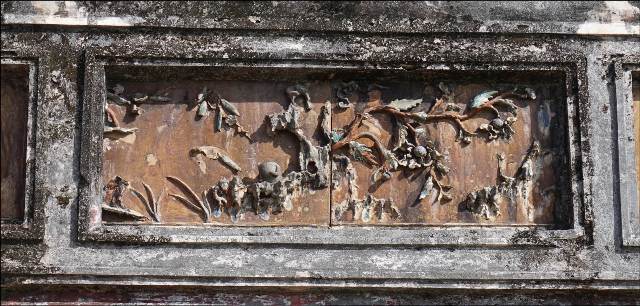
On the screen in the Forbidden Purple City, enameled ceramics are the highlight.
The royal art of the Nguyen Dynasty left many quintessential constructions which reflect the wisdom and creativity of an era. Besides the system of royal tombs and folk architectural structures, Hue Citadel is perhaps the largest and the greatest construction with many outstanding features, which still exists now. The central area of the Citadel is the Imperial City with the Forbidden Purple City, serving as the residence for the emperor and his family. Currently, most of the structures in the Forbidden Purple City are either ruined or damaged, but fortunately, there remains the main screen just behind Can Chanh Palace, decorated with diverse ornaments, especially the panels with embossed enameled ceramic details on the front and the back of the screen in the "one-poem-one-painting" style, very popular in Nguyen Dynasty fine arts.
Whether it is folk, religious or royal architecture, in front of each construction, typically, there is always a screen in compliance with feng shui principles of Thuan Hoa residents. Besides masonry painting, masonry embossment and ceramic mosaics, the system of decorative panels on the two supplemental wings is the rarest, the most original and the most beautiful work that still exists. The main screen is 41m long; the two supplemental wings on the right and on the left are 10m long each. Just on one side, there are up to 55 decorative panels, embellished with ceramic mosaics, enameled ceramics and masonry embossment. The middle part of the screen contains 25 panels with images of flowers, fruits, leaves and vines; some other panels with precious objects such as the pen, the book, the gourd, etc. Each supplemental wing contains 15 panels, 8 of which are decorated with enameled ceramics in themes such as bát bửu (eight precious objects), bát quả (eight fruits), fairy tales and flowers and leaves. They all together form strips of decorative panels special in color, material and aesthetics.
The enameled ceramic panels on this screen are varied in shape. There are oval panels, very rare in the Nguyen Dynasty's times. There are two panels of enameled ceramics featuring the plastered cái khánh (a musical instrument) with vividly intertwined images of objects such as the chessboard, the fan, the book and the vine. Other themes include the four seasons, the Confucian themes such as the four elegant pursuits (playing musical instruments, playing chess, making poetry, drinking wine), the four careers (fisherman, woodcutter, farmer, animal tender), etc. Especially, the upper corner of each supplemental wing is decorated with a multicolored enameled ceramic board on which there is the phoenix instead of dragons, a popular decorative motif at important places in the Imperial City. Almost all typical traditional decorative motifs of the Nguyen Dynasty such as mai điểu (apricot blossom and bird), tùng lộc (deer and pine), liên áp (duck and lotus), cúc điệp (butterfly and daisy), tam đa (happiness, wealth and longevity) and other themes such as tứ linh (four sacred animals), bát quả (eight fruits, usually peaches), bát bửu (eight precious objects), bồng ngũ quả (tray of five fruits), Vạn symbol (Swastika in Buddhism), etc. are present on the same screen, which is very rare of that time. The special thing is, instead of masonry painting, masonry embossment or ceramic mosaics which are often seen on other constructions, on the screen in the Forbidden Purple City, enameled ceramics are the highlight.
Since the use of terra cotta and enameled ceramics in decoration is not as popular during the Nguyen Dynasty's times as other materials, the screen with ornaments on it becomes something very rare, precious and original, reflecting the period when terra cotta and enameled ceramics thrived in Hue.
Although this main screen in the Forbidden Purple City has been damaged to some extent, what remains has proved a remarkable achievement in the use of terra cotta and enameled ceramics in decoration in the Nguyen imperial court. This also marks the early stage of the combination of the traditional architecture with the European constructing style. It reflects the achievement in Vietnamese traditional decoration and fine arts in the early 20th century. The screen is now an original treasure in the fine art legacy of the Nguyen Dynasty.
Story and photo: Pham Minh Hai